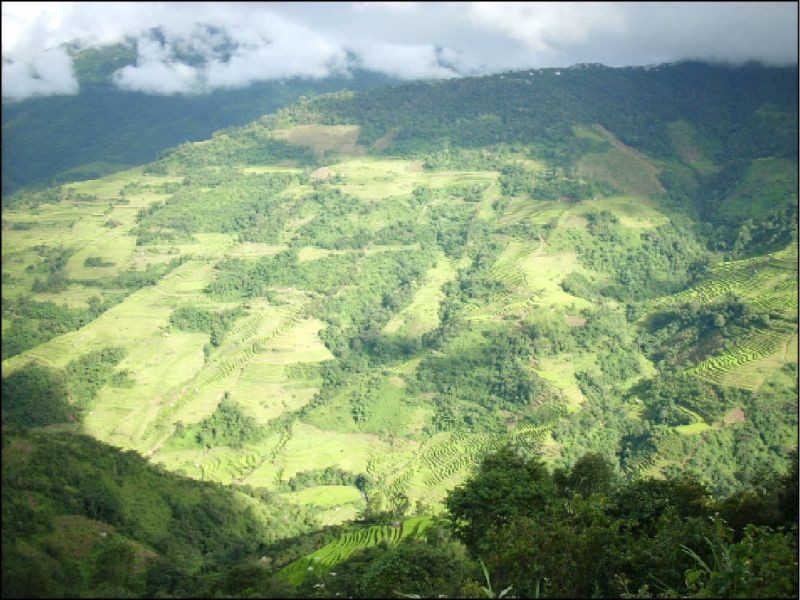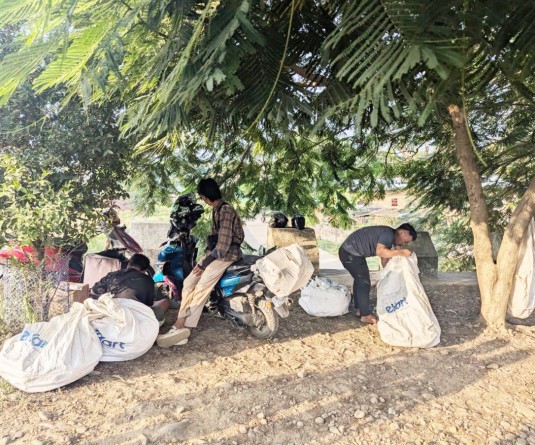A large area of lush green paddy field somewhere in the Naga Hills. (Morung File Photo)

Evaluation report of State’s marketing facilities for agriculture & allied products calls for provision of quality seeds to the farmers
Our Correspondent
Kohima | June 28
The Directorate of Evaluation, Nagaland; Kohima has recently brought out evaluation report of the marketing facilities for agriculture and allied products in Nagaland.
The state level study on marketing facilities for agri and allied products mainly focuses on market scenario and status of Agriculture Produce Marketing Committees (APMC) in the districts, stated a copy of the report which make available to The Morung Express.
The report stated that though the marketing facilities in the state are at minimal ebb, the study has ascertain the potentially of various seasonal crops which are feasible and economically viable for commercialization.
“It is anticipated that the evaluation report will provide insight for transforming the agro-based economy to all round sustainable development,” the report stated.
In executive summary, the report stated that Nagaland is an agrarian economy. There are three types of cultivation practice in the state- jhum/shifting cultivation, terrace cultivation and wet rice cultivation. The main crops are rice, maize, millets, pulse, oil seeds, soyabean, sugarcane, potatoes and fibres.
The report stated that agricultural credit is required for purchase of agricultural inputs and machinery. It was found that there is very minimal reach of credit to the farmers (2.9%, n=989).
The APMCs have reported that no grant-in-aid and financial allocation was received after the financial year 2013-14.
It may be pointed out that the various APMCs in the districts are willing to work for the progress of marketing system, but it has remain non-functional due to lack of financial resources.
“Most of the farmers are reported to use only locally available seeds, the productivity of those seeds is significantly low (72%, n=854), the report stated and suggested that the government should provide quality seeds to the farmers in order to increase the productivity of agriculture products.
“Most of the farmers had no access to marketing opportunities. Therefore, it is imperative to create marketing linkages for the farmers to sell the goods,” the report stated.
The study also maintained that capacity building for the farmers is vital for the success in agriculture, adding that knowledge and skill upgradation in the field of agricultural practices, and keeping in pace with the change in agricultural technology needs to be imparted to the farmers at the regular interval of time.
The basic functionality and structure of APMC need to be revived, so as to adapt to the changing economic scenario, the report added.
Stating that Nagaland is predominantly an agrarian economy, the study observed that marketing of agricultural products is critical for development of agriculture marketing system in the state.
The bottlenecks for the growth and development of agriculture marketing system in the state, according to the evaluation report, are lack of marketing infrastructure for agri and allied products, presence of subsistence farming, reliance on traditional method of seeds use, non availability of financial assistance and inadequate transportation facility.
“The state produces huge quantities of crops, pulses, fruits, vegetables and other allied products. However, there is lack of linkage between the farmers and the market and lack of knowledge of the market price of the agricultural produce by the farmers is also a challenge,” the report stated.
In order to facilitate agricultural marketing system, APMCs were constituted throughout the state as per Nagaland Agricultural Produce Marketing (Development and Regulation) Act 2005.
Main findings of evaluation study
Marketing infrastructure
• Marketing infrastructure is a basic component for growth and development of agricultural economy of the state. It comprises of godown, marketing complex, cold storage, processing and packaging and other supporting facilities.
• There is complete lack of marketing infrastructural in the rural area. It is found that there is wastage of large quantities of agricultural produces as it remains unsold due to non availability of access to market. Because, there is no processing and packaging unit in rural areas.
• There is no storage facility in the villages for storing agricultural produce.
• The Nagaland State Agriculture Marketing Board (NSAMB) and APMCs in the state has minimal infrastructure for facilitating marketing of agricultural produced. NSAMB at Dimapur and APMCs of Mokokchung, Phek, Tuensang and Jalukie is reported to have functional godown. Tuensang APMC, Kohima APMC and Niuland APMC have marketing shed for the sale of agricultural products. Tuensang APMC and Mokokchung APMC have Wright Bridge. But all those facilities have remained under utilized for the development of agricultural marketing.
• APMC Baugty has initiated a weekly bazaar at Baugty Town. It has been observed that most of the products sold at the bazaar were imported from Assam. Thus it has not benefited the local farmers. Though Tuensang APMC has marketing shed, it still remain unutilized by the traders as it is far from the main town.
Marketing linkages
• Access to marketing opportunities is vital for the growth of rural economy. It has been observed that most of the farmers have no access to marketing facilities. The farmers are also ignorant of the values of agricultural products in the market.
• It is found that most of the farmers sell their products to the traders within the village itself (45.5%, n=989). The farmers also sell directly to the consumers (19.11%, n=989).
• APMC Kohima and APMC Niuland have organized sales exhibition for the farmers in which 160 farmers at Kohima and 15 farmers at Niuland have participated. It is an innovative program undertaken by the APMC.
Capacity building
• Capacity building training for the farmers is vital for the success in agriculture. Knowledge and skill upgradation in the field of agricultural practices, and keeping in pace with the change in agricultural technology needs to be imparted to the farmers at regular interval of time.
• 6 APMCs in the state have organized training programme for the traders, farmers, APMC officials and NGOs during the reference period.
Agriculture credit
• Agriculture credit is crucial for the growth and development of agricultural sector in the state. There are two source of credit for the farmers. Institutional sources which include commercial bank, regional rural banks, micro financial institutions, government. Non- institutional sources are money lenders and relatives.
• Only 2.9% of farmers have obtain financial credit from government, bank and other agencies (n=989). It clearly indicates very minimal reach of agriculture credit to the farmers.
SEEDS
• Availability of wide range of seeds of superior quality in adequate quantity on a timely basis is vital for increase in productivity and also in maintaining quality of the products. It will in turn help the farmers to earn more income from the sale of the products.
• Most of the farmers are reported to use only locally available traditional seeds (72%, n=854). Some of the farmers receive seeds from government departments (7%, n=854). It is also found that 20% of the farmers purchase seeds from open market (n=854).
Logistic
• Movement of goods and services is vital for the growth and development of agriculture marketing in the state. Road transportation is the only means of transportation of agriculture produces to the market.
• It is found that the road network especially connecting villages and agricultural fields is completely miserable.
oreover, there is no transportation facility for the farmers as well as traders to bring agricultural produces to the market.
Suggestions
• It is found that almost all the APMCs in the state are defunct; the main reason is lack of financial allocation.
• Nagaland being an agrarian economy, more focus has to be given to the agricultural sector: agricultural productivity, marketing infrastructure and agro-based industries.
• Agri warehouse based on scientific method for storage and preservation of agriculture and allied products should be constructed at various strategic locations.
• There should be storage facility at all the village level.
• There are numbers of marketing shed on the highways and villages which remains unutilized by the farmers and traders as there are no buyers. Therefore, a viable market location should be identified for agricultural marketing.
• Processing and packaging units should be established as per the requirement of the region/area.
• An Agro-based industry is essential for the development of agricultural marketing in the state. It has to be set up in rural areas where raw materials are readily available.






